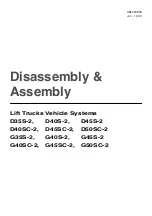
Maintenance
45
• Add 0.004 to the reading of each cell for
every 10° / 5.5° C above 80° F / 26.7° C.
• Subtract 0.004 from the reading of each cell
for every 10° / 5.5° C below 80° F / 26.7° C.
⊙
Result: All battery cells display an adjusted
specific gravity of 1.277 or higher.
The battery is fully charged. Proceed to step
12.
¤
Result: One or more battery cells display a
specific gravity of 1.217 or below. Proceed to
step 8.
8. Perform an equalizing charge OR fully
charge the batteries and allow the
batteries to rest at least 6 hours.
9. Remove the battery vent caps and check
the specific gravity of each battery cell
with a hydrometer. Note the results.
10. Check the ambient air temperature and
adjust the specific gravity reading for
each cell as follows:
• Add 0.004 to the reading of each cell for
every 10° / 5.5° C above 80° F / 26.7° C.
• Subtract 0.004 from the reading of each cell
for every 10° / 5.5° C below 80° F / 26.7° C.
⊙
Result: All battery cells display a specific
gravity of 1.277 or greater. The battery is fully
charged. Proceed to step 12.
¤
Result: The difference in specific gravity
readings between cells is greater than 0.1 OR
the specific gravity of one or more cells is
1.172 or less. Replace the battery.
11. Check the battery acid level. If needed,
replenish with distilled water to 1/8 inch /
3 mm below the bottom of the battery fill
tube. Do not overfill.
12. Install the vent caps and neutralize any
electrolyte that may have spilled
.
a Batteries b Quick disconnect
c 300A fuse d Charger
Suitable for all models
:
13. Check each battery pack and verify that
the batteries are wired correctly.
14. Inspect the battery charger plug and
pigtail for damage or excessive insulation
wear. Replace as required.
15. Connect the battery charger to the
110-240V 50/60HZ AC power.
⊙
Result: The charger should operate and
begin charging the batteries.
¤
Result: the charger alarm sounds and the
LEDs blink one time, correct the charger
connections at the fuse and battery. Ensure
that the charger operates correctly and begin
charging the batteries.
Note: For best results, use an extension cord
of adequate size with a length no longer than
50 feet/ 15 m.
Note: If you have any further questions
regarding the battery charger operation,
please contact the Scissor Service
Department.
B-2
Inspect the Electrical Wiring
This procedure should be performed every
250 hours or quarterly, whichever comes first.
Maintaining electrical wiring in good condition
is essential to safe operation and good
machine performance. Failure to find and
replace burnt, chafed, corroded or pinched
wires could result in unsafe operating
conditions and may cause component
damage.
Summary of Contents for ES100E
Page 5: ...Decals 3 ...
Page 7: ...Decals 5 ...
Page 9: ...Decals 7 ...
Page 59: ...Electrical Schematic Diagram 57 ES40E ...
Page 60: ...Electrical Schematic Diagram 58 ES60E ES80E ES100E ES120E ...
Page 62: ...Hydraulic Schematic Diagram 60 ES80E Y7 Y7 G1 4 19 Y1 Y1 Y2 Y2 Y3 Y3 Y4 Y4 Y5 Y5 Y6 Y6 ...
Page 64: ...Hydraulic Schematic Diagram 62 Maintenance Record Date Note ...
Page 65: ......
















































